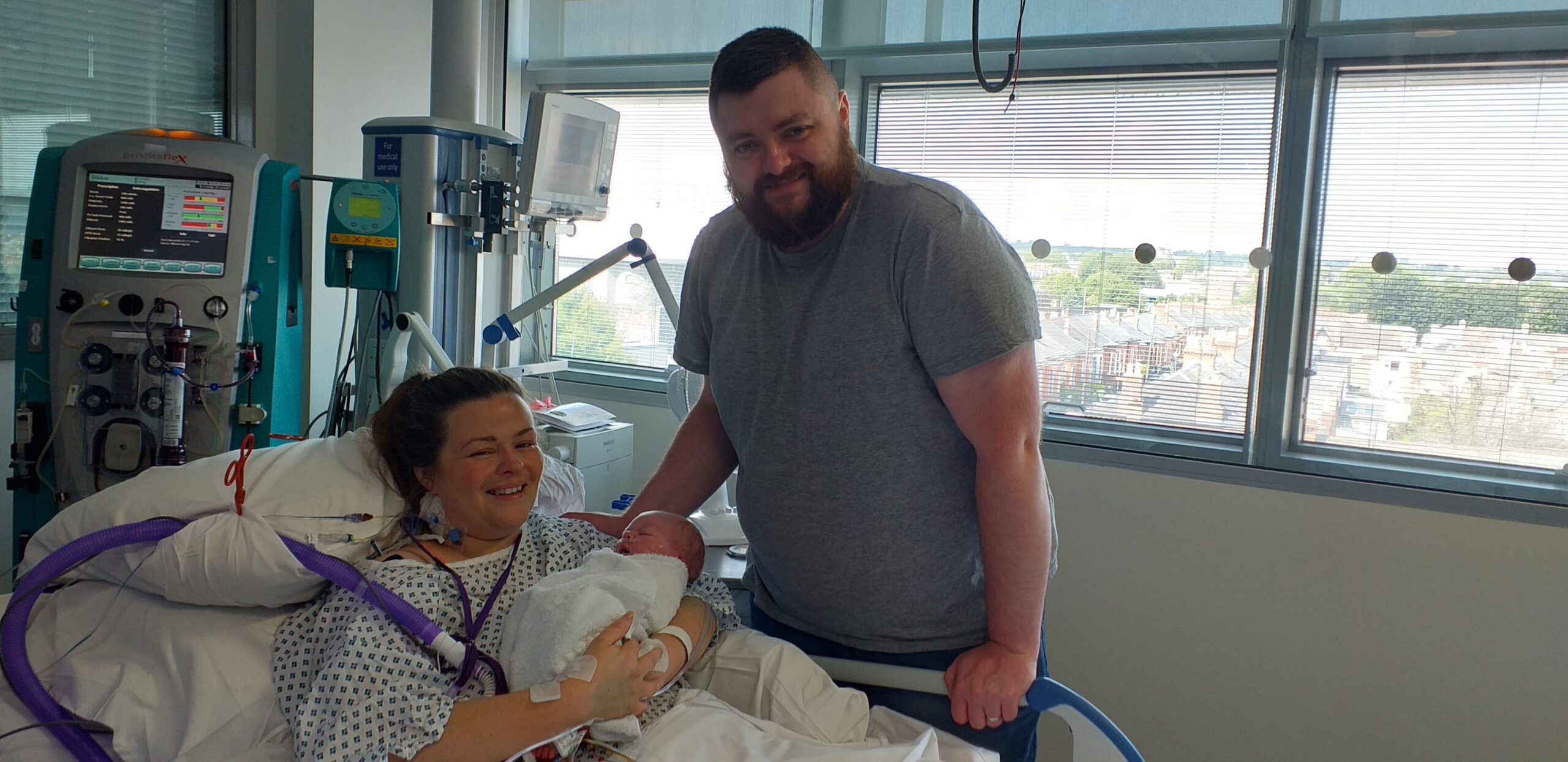
Name: Christopher Burns
Location: Dublin, Ireland
Child’s Birth Year: 2019
Keywords: HIE Dad, Seizures/Epilepsy, Cerebral Palsy, PTSD & Mental Health
At the time they found out they would be having a baby, Chris and his wife, Steph, had been happily married for a few years. Chris had been working retail jobs all of his life and was training to become a health care assistant where he lived in Dublin, Ireland. As he was beginning to dip his toes into the field of health, never did he imagine the new world full of appointments, medical jargon, and uncertainty that he would soon be introduced into.
Steph’s pregnancy had been relatively healthy and uneventful, but a few days before she had to go into induced labor, she began to notice jolting waves of pain just below her ribs, which ebbed and flowed. Originally, they thought these pains were attributable to typical early labor pains, but soon it became too much for Steph to bear, so they packed their bags and went to the hospital.
The day of Ella’s birth marked one of the most traumatic experiences of Chris’s life. During the delivery, there was a cascade of problems. For at least seven and a half minutes prior to birth, clinicians couldn’t read a heartbeat on Ella, and then, at nine and a half minutes outside of the womb, Ella received two adrenaline shots and was resuscitated. In the meantime, Steph had a serious subarachnoid hemorrhage that put her life in the balance as well.
The next few days for Chris were lonely and overwhelming. The person he wanted and needed most to lean on for support—his wife—could not be there for him, since she needed to focus on her own recovery. Steph spent two days in an induced coma at a separate hospital from the Ella. Chris also only saw Ella for thirty seconds before she was hurried away. Ella still didn’t even have a name, and Chris had no idea what was happening. The only information he received was from the clinician, who quickly told him Ella needed to start therapeutic cooling.
The next day, Chris received the overwhelming news that Ella essentially had no brain activity. He was told by the clinicians that, if Ella wasn’t showing any brain activity on the EEG at the halfway mark of the cooling process, it would be time for Chris to make the final decision regarding withdrawing any life-sustaining treatment. As if the prospect of making this impossible decision were not overwhelming enough, he was simultaneously told that Steph probably would not make it. Even if she did miraculously survive, there was little chance of her being the same woman Chris had previously known and loved.
Chris doesn’t think of himself as a religious person by any means, but, as he went back to the NICU, he prayed by Ella’s side to anyone or anything that would listen. Then, just four hours before Chris would have to make his final decision, he heard a sound and saw a flicker of tiny brain waves start to bounce across the screen. For the first time since they landed in the hospital, Chris found himself exhaling a sigh of relief.
In the morning, two days following Ella’s birth, Steph had, thankfully, also woken up. Since he was previously told that Ella’s chance of survival was 10% and Steph’s 50%, Chris felt blessed that they had both pulled through. However, his journey navigating the NICU was far from over. He was told specifically not to talk to Steph about Ella’s condition, as it might upset her and affect her healing. In Ireland, because of the healthcare system, Ella wasn’t able to be scheduled for an MRI until eight days after she was born. The next week for Chris meant sitting with uncertainty, keeping his anxieties about Ella to himself, and waiting anxiously for MRI day, when he could receive more definitive results.
It wasn’t until MRI day, upon learning that Ella’s basal ganglia was completely wiped out, that Chris first heard the words “hypoxic ischemic encephalopathy” or HIE. Finally, being told some tangible condition, Chris decided to search the web to find anything that could provide him with a sense of clarity. As he sat in a bathroom cubicle in the children’s hospital, he stumbled across Hope for HIE on Facebook. For him, discovering Hope for HIE was a game-changer. It was the first time in days that he didn’t feel completely alone. Especially since he didn’t have Steph to bounce things off of, scrolling through the various pages affiliated with Hope for HIE, such as the New to HIE page, and learning about the experiences of different HIE families, was extremely helpful. Even though he wasn’t in the headspace to actively post in the groups himself, just the process of reading vignettes of other parents’ experiences helped him start to wrap his mind around this new life. And even though Chris didn’t find other fathers quite in the same boat as him, having to navigate a portion of the NICU journey solo, it was validating to know there were other fathers out there who similarly had to cope with an influx of grief and anxiety.
On day nine, the day after the MRI, Steph was finally able to hold and meet Ella. Even though it would still be a long road ahead—Ella would go on to stay in the hospital for five and a half weeks, and Steph would go on to stay in the ICU for three and a half weeks—being able to confide in Steph from this point forward made a world of difference for Chris.
During those weeks before Steph was discharged from the hospital, Chris was basically living off of energy drinks and caffeine, only spending four or five hours of the day at home and splitting the rest of his time between hospitals. He was exhausted, both mentally and physically. Looking back at this time, Chris wishes he had prioritized also looking after his own health more. He cannot emphasize enough to other parents the importance of engaging in self-care. Even if it seems like you’re too busy and overwhelmed, self-care can mean something as basic as taking a short walk or quick nap. Another key piece of advice he has for parents is to not let their relationships with their partners falter. When parents are overwhelmed, or when they may be processing their emotions in different ways from one another, it can be easy to fall into a routine of not communicating effectively. What helped Chris and his wife tremendously was remembering that there was a solid relationship before all this happened. With this in mind, they made an effort to not let their “new normal” stop the communication, the talking, or the intimacy between them.
Today, Ella’s life may look different from many other children her age, but that doesn’t mean it’s not a good life or that there aren’t moments of triumph, hope, and joy. She may have a variety of impacts from her HIE, but she’s resilient, continuing to try her best in physical therapy. Throughout the journey, Ella truly has taught Chris to love the struggle—every child has to fall down before they walk. Ella just may have to do it a few more times than a neurotypical child.
This mindset is reminiscent of a quote that Chris holds onto: “I know it seems hard, but you’re doing your very best.” Chris really wants parents to know that their best may not look the same every day, and that is totally okay. As long as you’re trying your personal hardest, every day, to be present for your family and your child, that’s what matters. When Ella smiles when he plays the right song for her, or does physio with her, these moments of joy and togetherness show him that all his hard work—from learning how to use equipment like the PEG tube, to advocating on Ella’s behalf with the Health Service Executive (Ireland’s healthcare system)—is irrevocably worth it.
In the future, Chris hopes more people become aware of HIE, since the condition is largely unknown outside of those who are directly impacted. He finds that, even when he talks to people within the medical field, such as physicians or occupational therapists, they tend to equate HIE with “brain damage” or “brain death.” While this may be true, there is so much more nuance to HIE than just that—the brain injury is just the event, but, from there, children can be impacted in many different ways, depending on the location and severity of the injury. For Ella, the impact looks like scoliosis, epilepsy, and cerebral palsy, among other things. Chris is optimistic, though, that, as children with HIE survive longer, thanks to therapeutic cooling and other interventions, the increased prevalence among the population will call more attention to HIE and spark interest among the research community.
In addition, in the future, he hopes that more clinicians will learn how to be empathetic when interacting with parents. Chris still remembers how devastated he was when, the day Ella was born, the pediatrician told him that Ella would live a difficult and tired life, even if she were to make it out of the NICU at all. In one of the most terrifying moments of Chris’s life, the harshness of these words only made things worse. The pediatrician did apologize to him at a follow-up appointment, months later, stating, “As clinicians, we tend to see the world in black and white. We don’t see the person in the middle—the gray area—which is something we definitely need to do more often. And, for that, I am sorry.” While Chris appreciated the apology, he wishes people—clinicians, but also the general public—would stop painting a picture of a life with disability as a tragic life. Even with all her health complications, Ella’s life is, by no means, solely “difficult and tired.” Difficult and tired at times, of course. But it is also a life marked with hope, love, joy, laughter, and perseverance.

Connect with families, read inspiring stories, and get helpful resources delivered right to your inbox.